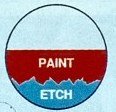Steel tubes are strong and functional, and when finished well, they appear sleek and shiny. But if you’ve ever worked with raw steel tubing, you know the road from freshly cut to product-ready is not an easy one.
Burrs, rust, grime, and jagged edges are ugly defects that can be dangerous and can damage machinery, compromise structural integrity, or just ruin the aesthetic you were going for. To fix that, you need a process that’s equal parts art and science.
In the world of surface prep, let’s learn how to clean & polish steel yubes the right way.
The Defects that Result from Cutting Steel
The journey of every steel tube starts with a cut. Unfortunately, though cutting steel tubes is functional, it does not happen in a clean manner. Rough edges, called burrs, cling to the ends. And if your cutting process uses coolant or water, you can also encounter the problem of rust.
Rust is a reddish-brown oxidation, and it digs deep. Over time, it leads to pitting, weakening your metal, and leaving unsightly scars. The first step of finishing is to clean & polish steel tubes before putting them into use or on display.
Step One: Deburr and De-Rust
Cleaning and polishing with a cloth is not enough. To tackle those burrs and the rust, you need a mass finishing process that counters it with aggression. Vibratory tumbling is the main process used here for industrial-strength surfaces.
In this method, steel tubes are tumbled with abrasive media. Let us study the case where a general-purpose Ceramic Media is used. This media is tough, angular, and energetic and known for grinding away the burrs, removing oxidation, and smoothing over any pitting from rust.
Ceramic media comes in different shapes. When you’re working with round tubes, you need to choose something that can get into the curves and along the edges. That’s where the Ceramic Cylindrical Wedge works great. Its shape is practically designed to cover these areas of steel tubes well.
After a session in the vibratory tumbler, steel tubes are cleaner, smoother, and totally burr-free. But let’s not stop there. To truly clean & polish steel tubes, there is the next phase of refinement.
Step Two: Polish to Perfection
Once the steel tubes are clean and de-rusted, it’s time to bring out the shine. This next round of tumbling uses the same aggressive ceramic media in a different form. For a more refined approach, the Precision Ceramic Sphere is used. This is where porcelain meets polishing power. These smooth, rounded balls move over the metal’s surface, buffing it gently until it starts to gleam.
As they start to work, you will see a bright, even shine take form. This finish is suitable for most applications. But if you’re chasing a mirror-like look, one that gleams like chrome in the sunlight, you can take it further. With additional steps like dry tumbling with organic compounds or even hand-buffing with a polishing compound, you can make your steel tubes dazzle.
Routine Cleaning vs. Aggressive Treatment
Not every steel tube needs an extreme makeover. Sometimes, you just need a little maintenance.
Routine Cleaning
Here, you just need light tumbling or ultrasonic cleaning. These processes can remove surface dust, light oil, or fingerprints. If your tubes are already polished and you just want to keep them that way, this type of simple cleaning protocol every few weeks can preserve their shine.
But when you’re dealing with raw industrial-cut steel or pieces that have been exposed to moisture, road grime, or time itself, aggressive treatment becomes essential.
So, which one should you opt for?
Here’s a quick guide:
| Condition of Tube | Treatment Needed |
| Light dust, smudges | Routine ultrasonic or solvent cleaning |
| Mild oxidation or discoloration | Light ceramic tumbling or abrasive paste polish |
| Heavy burrs and rust | Full vibratory tumbling with Ceramic Wedge |
| Final finishing | Polishing with Precision Ceramic Spheres |
| Mirror-like shine | Dry tumbling + hand buffing |
So, whether you’re restoring old tubing, prepping parts for painting or coating, or creating components for high-end applications, you need to remember this: To clean & polish steel tubes is a make-or-break step. It’s not just an aesthetic step but a functional one.
Why is There a Need to Clean & Polish Steel Tubes?
You need to clean & polish steel tubes because a polished tube performs better.
- Smooth surfaces reduce drag in fluid systems.
- Polished tubes are easier to weld and coat.
- Clean surfaces ensure better corrosion resistance.
- And shiny tubes look much better.
A poorly finished part sends the wrong message. A clean, polished tube reflects quality and precision.
You’re not alone in the quest to Clean & Polish Steel Tubes. Kramer Industries has been the go-to source for mass-finishing solutions for decades. From ceramic media to vibratory tumblers to polishing compounds, Kramer offers the tools, techniques, and guidance to help you clean, prep, and polish steel tubes like a pro. Explore our full line of finishing equipment and media because your metal deserves the best.




